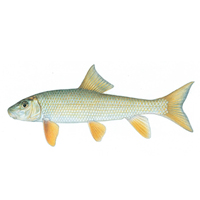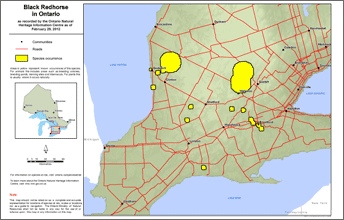Black redhorse
Scientific name: Moxostoma duquesnei

Cover photo credit: Joseph R. Tomelleri
Status
Threatened
“Threatened” means the species lives in the wild in Ontario, is not endangered, but is likely to become endangered if steps are not taken to address factors threatening it.
Date added to the Species at Risk in Ontario List
The Black Redhorse was already assessed as threatened when the Endangered Species Act took effect in 2008. A reassessment in 2016 confirmed this status.
Read the assessment report (PDF)
What it looks like
The Black Redhorse fish is a member of the sucker family. It grows to about 50 centimetres in length and weighs up to one kilogram. It has a long, rounded snout and a downward facing, typical sucker mouth. The back is grey, brassy or olive brown with a silvery blue overtone. The sides are a silver blue and the belly is silver or milky white. The fins are usually a slate grey colour but the fins (especially those on the bottom of the body) can be pale orange.
Where it lives
In Ontario, the Black Redhorse lives in pools and riffle areas of medium-sized rivers and streams that are usually less than two metres deep. These rivers usually have few aquatic plants, a moderate to fast current, and a sandy or gravel bottom. In the spring, it migrates to breeding habitat where eggs are laid on gravel in fast water. The winter is spent in deeper pools. Adults feed on crustaceans and aquatic insects, while the young fish feed on plankton.
Where it’s been found in Ontario
In Canada, the Black Redhorse is found only in southwestern Ontario at a few locations in the Bayfield River, Maitland River, Ausable River, Grand River, Thames River, and Spencer Creek watersheds.
View a larger version of this map (PDF)
What threatens it
In Ontario, availability of suitable habitat, including breeding habitat, is the main limiting factor to the Black Redhorse. It requires clean, clear water and does not do well in rivers that are muddy or polluted. Urbanization in the Grand and Thames watersheds represents a threat to these populations. Dams and other barriers that can limit fish movement are also considered a threat.
Action we are taking
Threatened species and their general habitat are automatically protected under Ontario’s Endangered Species Act, 2007.
Recovery strategy
A recovery strategy advises the ministry on ways to ensure healthy numbers of the species return to Ontario.
Read the executive summary and the full document (July 12, 2023).
Government response statement
A government response statement outlines the actions the government intends to take or support to help recover the species.
Read the government response statement (April 17, 2024).
Habitat protection
General habitat protection — June 30, 2013
What you can do
Report a sighting
- Report a sighting of an endangered animal or plant to the Natural Heritage Information Centre. Photographs with specific locations or mapping coordinates are always helpful.
Volunteer
- Volunteer with your local nature club or provincial park to participate in surveys or stewardship work focused on species at risk.
Be a good steward
- Private land owners have a very important role to play in species recovery. If you find a nesting on your land, you may be eligible for stewardship programs that support the protection and recovery of species at risk and their habitats.
- Invasive species seriously threaten many of Ontario’s species at risk. To learn what you can do to help reduce the threat of invasive species, visit:
Report illegal activity
- Report any illegal activity related to plants and wildlife to
Toll-free: 1-866-MOE-TIPS (663-8477) .
Quick facts
- During the breeding season, the body colour of the male Black Redhorse changes from bluish-silver to a darker greenish-black.
- The Black Redhorse looks very similar to the golden redhorse. Experts look closely at the lips, tail fins, and the number of scales to correctly identify the species.
